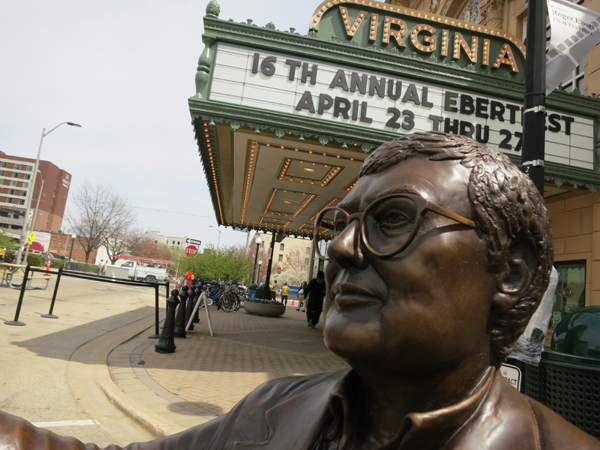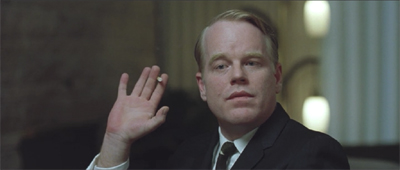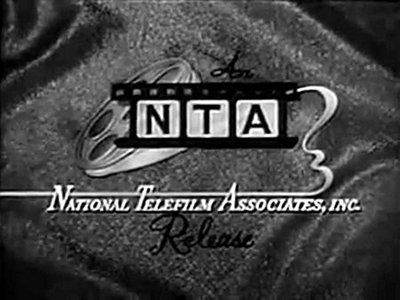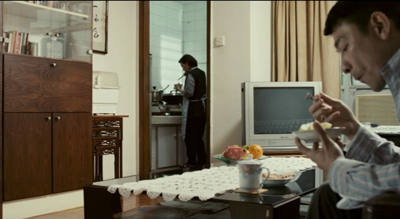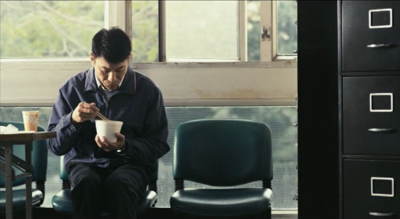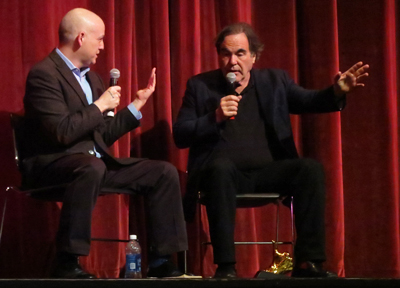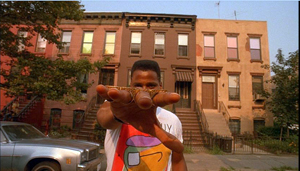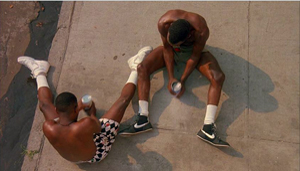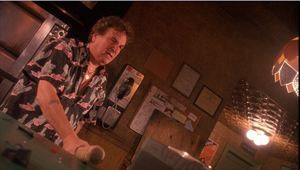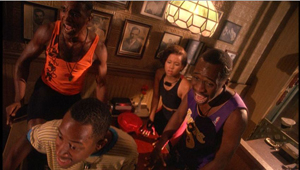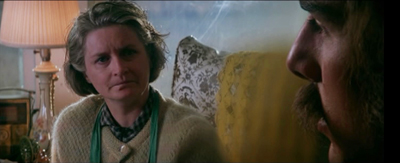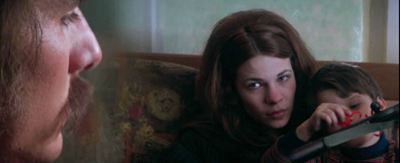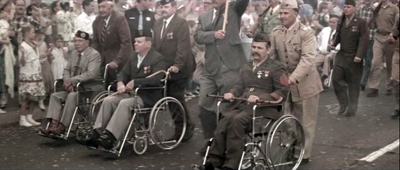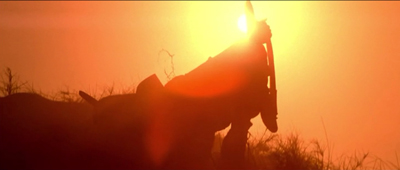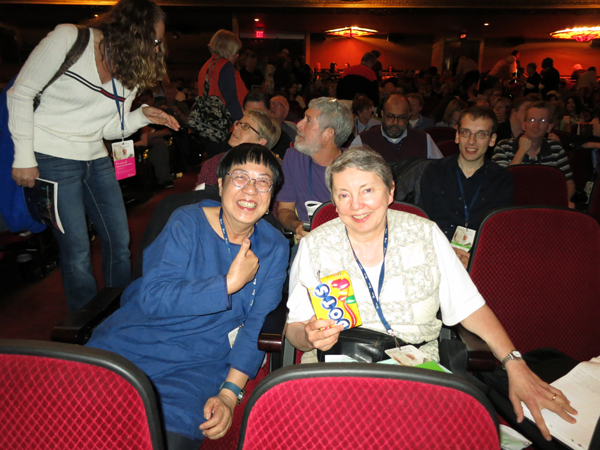Unveiling Ebertfest 2014
Wednesday | April 30, 2014 open printable version
open printable version
Kristin here:
In the early days of Ebertfest, Roger personally introduced every film at this five-day event, which took place this year from April 23 to 27. He would be onstage for the discussions and question sessions after each screening, often joined by directors, actors, or friends in the industry.
In the summer of 2006, there began the long battle with cancer that Roger fought so determinedly. He withdrew gradually from full participation in the festival that he had founded in his hometown of Champaign-Urbana sixteen years ago. He struggled to immerse himself in the festival, even though repeated surgeries had robbed him of his voice. He introduced fewer films, doing so with his computer’s artificial voice, and when even that became too taxing, he sat in his lounge chair at the back of the Virginia Theater, enjoying the event and occasionally appearing onstage with a cheery thumbs-up. Finally, last year on April 4, less than three weeks before the fifteenth Ebertfest, he passed away. That year’s festival became a celebration of his life.
The celebration continued this year, though on a more upbeat note. Some films were chosen from a list that Roger had left to his wife Chaz and festival organizer Nate Kohn, and they selected others in the same indie spirit. The tradition of showing a silent film with musical accompaniment was maintained. As always, the festival passes sold out, and the crowd, including many long-time regulars, enthusiastically cheered both films and filmmakers.
The tributes
Roger did not live to see the documentary devoted to his life and based on his popular memoir of the same name, Life Itself. It premiered in January at this year’s Sundance Film Festival. He participated in its making, however, encouraging director Steve James (whose 1994 documentary Hoop Dreams Roger had championed) to film him during the final four months of his life. Some of this candid footage reveals the painful and exhausting treatments Roger underwent, but much of it stresses his resilience and the support of Chaz and the rest of his family.
Life Itself was the opening night film. James has done a wonderful job of capturing the spirit of the book and in assembling archival footage and photographs, interspersed with new interviews. The result is anything but maudlin, with a candid treatment of Roger’s early struggles with alcoholism and an amusing summary of Roger’s prickly but affectionate relationship with his TV partner Gene Siskel.
Life Itself was picked up for theatrical distribution by Magnolia Pictures and will receive a summer release, followed by a showing on CNN. (Scott Foundas reviewed the film favorably for Variety, as did Todd McCarthy for The Hollywood Reporter.)
Another tribute followed the next day, when a life-size bronze statue of Roger by sculptor Rick Harney was unveiled outside the Virginia Theater (above). Harney portrays Roger in his most famous pose, sitting in a movie-theater seat and giving a thumbs-up gesture. There is an empty seat on either side of him, so that people can sit beside the statue and have their photos taken. (See the image of Barry C. Allen in the section “Of Paramount importance,” below.)
Far from silent
Roger was a big fan of the Alloy Orchestra, consisting of (L to R above) Terry Donahue, Ken Winokur, and Roger Miller, who specialize in accompanying silent films. They have appeared several times at Ebertfest, playing original music for such films as Metropolis and Underworld. Rather than taking a traditional approach to silent-film music, using piano, organ, or small chamber ensemble, they compose modern scores, played on electronic keyboard combined with their well-known “rack of junk” percussion section, including a variety of found objects, supplemented with musical saw, banjo, accordion, clarinet, and other instruments. The result is surprisingly unified and provides a rousingly appropriate accompaniment to the silents shown at Ebertfest over the years.
I have had the privilege of introducing the film and leading the post-film Q&A on some of these occasions, including for this year’s feature, Victor Seastrom’s 1924 classic, He Who Gets Slapped. (Swedish director Victor Sjöström used the Americanized version during his career in Hollywood.) I put the film in context by pointing out three important historical aspects of the film. First, it was the first film made from script to screen by the newly formed MGM studio, formed in 1924 from the merger of Goldwyn Productions, Metro, and Louis B. Mayer Pictures. (Two earlier releases by MGM were Norma Shearer vehicles which originated at Mayer.) Second, it was probably the film that cemented Lon Chaney’s stardom, after his breakthrough role as Quasimodo in the 1922 Hunchback of Notre Dame. Starting in 1912, Chaney had been in well over 100 films before Hunchback, many of them shorts and nearly all of them supporting roles. Third, He Who Gets Slapped was Seastrom’s second American film after Name the Man in 1923, and a distinct improvement on that first effort.
Naturally MGM wanted a big, prestigious hit for its first production, and He Who Gets Slapped came through, being both a critical and popular success–and also boosted Norma Shearer to major stardom. Seastrom and Chaney both stayed on at MGM, though the former returned to European filmmaking after the coming of sound and Chaney died in 1930.
I was joined for the post-film discussion by Michael Phillips of the Chicago Tribune, and we talked with Donahue and Winokur while Miller sold the group’s CDs and DVDs in the festival shop. They revealed that this new score had been commissioned by the Telluride Film Festival and that it was a project that appealed to their taste for off-beat films. There were many questions from the audience, and we suspect that the Alloy Orchestra will continue to be a regular feature of the festival.
A cornerstone of indie cinema
Although Roger was occasionally criticized for supposedly lowering the tone of film reviewing by participating in a television series, he and partner Gene Siskel regularly tried to promote indie and foreign films that didn’t get wide attention. Roger did the same in his written reviews, and Ebertfest was originally known as the “Overlooked Film Festival.” Inevitably it was shortened by many attendees to “Ebertfest,” and eventually that name became official. It reflects the wider range of films that came to be included, with the silent-film screening and frequent showings of 70mm prints of films like My Fair Lady that were hardly overlooked.
Among Roger’s friends was Michael Barker, co-founder and co-president of Sony Pictures Classics, one of the most important of the small number of American companies still specializing in independent and foreign releases. A long-time Ebertfest regular, Barker usually brings a current or recent release to show, along with filmmakers or actors. This year he was doubly generous, bringing Capote (2005, above), to which Roger had given a four-star review, and the current release Wadjda (2012).
Roger never reviewed the latter, but it is certainly the sort of film that he loved: a glimpse into a little-known culture by a first-time filmmaker with a progressive viewpoint. Wadjda is remarkable as the first feature film made in Saudi Arabia, where there are no movie theaters. Moreover, it was made by a woman, Haifaa Al-Monsour, and tells the story of a little girl who defies tradition by aspiring to buy and ride a bicycle in a country where this, like women driving cars, was illegal. (Below, Wadjda learns to ride a bicycle on a rooftop, hidden from public view.)
Both the film and Al-Monsour thoroughly charmed the audience. Barker interviewed her afterward, and she revealed that, not surprisingly, the making of the film was touched by the same sort of repression that it portrays. Women are not allowed to work alongside men in Saudi Arabia, so Al-Monsour had to hide in a van while shooting on location. Given that there is no cinema infrastructure in the country, the film was a Saudi Arabian-German co-production, with Arabic and German names mingling in the credits. We also learned that it has since become legal for Saudi girls to ride bicycles. Perhaps someday filmmaking will become more common there, and male and female crew members can work openly together.
Naturally Wadjda was made with a digital camera, since this new technology is crucial to the spread of filmmaking in places like the Middle East where there is little money or equipment for production. In contrast, Capote was shown in a beautiful widescreen 35mm print that looked great spread across the entire width of the Virginia’s huge screen. Naturally the screening became a tribute to the late Phillip Seymour Hoffman, giving his only Oscar-winning performance (out of four nominations) in the lead role.
Barker had brought with him a surprise guest, Capote‘s director, Bennett Miller, whose appearance had not been announced in advance. He discussed how he and scriptwriter Dan Futterman learned that there was a second, rival Capote film in the works, Infamous (2006), which also dealt with the period when the author was researching In Cold Blood. Miller and Futterman decided to press ahead, a wise move in that their film drew more attention than did Infamous. Much of the discussion was devoted to Hoffman’s performance and his acting style in general.
Capote was Miller’s first fiction feature. He had come to public attention with his documentary The Cruise (1998), which Roger had given a brief three-star review. Roger continued his support for Miller with a four-star review for Moneyball (2011). It’s a pity he did not live to see Miller’s latest, Foxcatcher, which will be playing in competition at Cannes in May.
Overlooked no longer
Perhaps no young filmmaker better demonstrates the impact that Roger’s support can have on a career than Ramin Bahrani. Roger saw his first feature, Man Push Cart, at Sundance in 2006 and invited it and the filmmaker to the 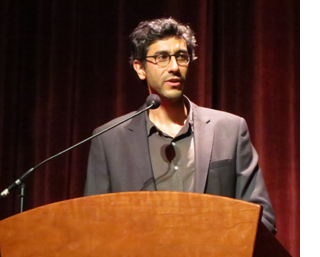 “Overlooked Film Festival” that April. (Roger’s Sundance review is here.) The film then played other festivals, notably Venice and our own Madison-based Wisconsin Film Festival. It won several awards, including an Independent Spirit Award for best first feature. In October Roger gave the film a more formal review, awarding it four stars. Man Push Cart never got a wide release, and it certainly didn’t make much money. Still, quite possibly the high profile provided by Roger’s attention allowed Bahrani to move ahead with his career.
“Overlooked Film Festival” that April. (Roger’s Sundance review is here.) The film then played other festivals, notably Venice and our own Madison-based Wisconsin Film Festival. It won several awards, including an Independent Spirit Award for best first feature. In October Roger gave the film a more formal review, awarding it four stars. Man Push Cart never got a wide release, and it certainly didn’t make much money. Still, quite possibly the high profile provided by Roger’s attention allowed Bahrani to move ahead with his career.
His second film, Chop Shop, brought him to Ebertfest a second time, in 2009. (Roger’s program notes are here, and his four-star review here.) At about that time, Bahrani’s third film, Goodbye Solo, was released. Given its modest budget, it did reasonably well at the box office, grossing nearly a million dollars worldwide (in contrast to Man Push Cart‘s roughly $56 thousand). Bahrani inched toward mainstream filmmaking with At Any Price (2012), starring Dennis Quaid and Zac Efron, and he is currently in post-production on 99 Homes, with Andrew Garfield, Michael Shannon, and Laura Dern. During the onstage discussion, he spoke of struggling to maintain a balance between the indie spirit of his earlier films and the more popularly oriented films he has recently made.
Bahrani visited Ebertfest for a third time this year, belatedly showing Goodbye Solo. We had enjoyed this film when it came out, and it holds up very well on a second viewing. It’s a simple story of opposites coming together by chance. An irrepressibly talkative, friendly immigrant cab driver, Solo (a nickname for Souléymane), becomes concerned when a dour elderly man engages him for a one-way trip to a regional park whose main feature is a windy cliff. He fears that William is planning suicide. Solo arranges to drive William whenever he calls for a cab and even becomes his roommate in a cheap hotel. Gradually, with the help of his young stepdaughter Alex, he seems to draw William out of his defensive shell.
As in Bahrani’s earlier films the main character is an immigrant and played by one, using his own first name (Souléymane Sy Savané). He’s the main character in that we are with him almost constantly, seeing William only as he does. William is a vital counterpart to him, however. He is perfectly embodied by Red West, an actor who worked for Elvis Presley and did stunt work and bit parts in films and television since the late 1950s. He may look vaguely familiar to some viewers, but he’s not really recognizable as a star and comes across convincingly as an aging man buffeted by life’s misfortunes.
Most of the film takes place in Winston-Salem, North Carolina, Bahrani’s hometown, with many moody, atmospheric shots of the cityscape at night. One crucial scene involves a drive into the woods and mountains, however, and much of it is filmed in a dense fog. One questioner from the audience asked if Bahrani had planned to shoot in such weather or if, given his short shooting schedule, the fog turned out to be a hindrance to him. He responded that he had dreamed of being able to shoot in fog and that the weather cooperated on the three days planned for that locale. In fact, he re-shot some images as the fog became denser, to keep the scene fairly consistent.
Bahrani’s presence at Ebertfest spans half its existence, from 2006 to 2014. As the festival becomes more diverse in its offerings, it is good to have him back as a reminder of the Ebertfest’s early emphasis on the “overlooked.”
Of Paramount importance
Logo for National Telefilm Associates, TV syndication arm of Republic Pictures.
DB here:
Among the guests at this year’s E-fest was Barry C. Allen. For over a decade Barry was Executive Director of Film Preservation and Archival Resources for Paramount. That meant that he had to find, protect, and preserve the film and television assets of the company—including not just the Paramount-labeled product but libraries that Paramount acquired. Most notable among the latter was the Republic Pictures collection.
We may think of Republic as primarily a B studio, but it produced several significant films in the 1940s and 1950s—The Red Pony, The Great Flammarion, Macbeth, Moonrise, and Johnny Guitar. John Wayne became the most famous Republic star in films like Dark Command, Angel and the Badman, and Sands of Iwo Jima. John Ford’s The Quiet Man was Wayne’s last for the studio, which folded in 1959. Next time you see one of the gorgeous prints or digital copies of that classic, thank Barry for his deep background work that underlies the ongoing work of his dedicated colleagues.
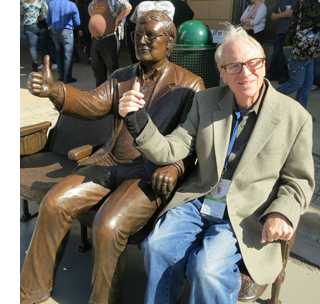 Barry told me quite a lot about conservation and restoration, but just as fascinating was his account of his earlier career. A lover of opera, literature, and painting since his teenage years, he was as well a passionate movie lover. An Indianapolis native, he thinks he saw his first movie in 1949 at the Vogue, now a nightclub. He projected films in his high school and explored still photography. He was impressed when a teacher told him: “If you want to make film, learn editing.” Soon he was in a local TV station editing syndicated movies.
Barry told me quite a lot about conservation and restoration, but just as fascinating was his account of his earlier career. A lover of opera, literature, and painting since his teenage years, he was as well a passionate movie lover. An Indianapolis native, he thinks he saw his first movie in 1949 at the Vogue, now a nightclub. He projected films in his high school and explored still photography. He was impressed when a teacher told him: “If you want to make film, learn editing.” Soon he was in a local TV station editing syndicated movies.
Hard as it may seem for young people today to believe, in the 1950s TV stations routinely cut the films they showed. Packages of 16mm prints circulated to local stations, and these showings were sponsored by local businesses. Commercials had to be inserted (usually eight per show), and the films had to be fitted to specific lengths.
WISH-TV ran three movies a day, and two of those would be trimmed to 90-minute air slots. That meant reducing the film, regardless of length, to 67-68 minutes. Barry’s job was to look for scenes to omit—usually the opening portions—and smoothly remove them. Fortunately for purists, the late movie, running at 11:30, was usually shown uncut, and then the station would sign off.
By coincidence I recently saw a TV print of Union Depot (Warners, 1932) that had several minutes of the opening exposition lopped off. We who have Turner Classic Movies don’t realize how lucky we are. Fortunately for film collectors, some stations, like Barry’s, retained the trims and put them back into the prints.
While working at WISH-TV, Barry began booking films part-time. He programmed some art cinemas in the Indianapolis area during the early 1970s, mixing classic fare (Marx Brothers), current cult movies (Night of the Living Dead), and arthouse releases like Discreet Charm of the Bourgeoisie—a bigger hit than anyone had anticipated. He also helped arrange a visit of Gloria Swanson with Queen Kelly; she carried the nitrate reels in her baggage.
At the same time, Barry was learning the new world of video editing, with ¾” tape and telecine. Because of his experience in television, Barry was contacted by Paramount to become Director of Domestic Syndication Operations. His chief duty was to deliver films to TV stations via tape, satellite, and prints. From that position, he moved to the preservation role he held until 2010, when he retired.
Barry is a true film fan. He has reread Brownlow’s The Parade’s Gone By many times and retains his love for classic cinema. The film that converted him to foreign-language cinema was, as for many of his generation, Children of Paradise, but he retains a fondness for Juliet of the Spirits, The Lady Killers, and other mainstays of the arthouse circuit of his (and my) day. He’s proudest of his work preserving John Wayne’s pre-Stagecoach films.
It was a great pleasure to hang out with Barry at Ebertfest. Talking with him reminded me that The Industry has long housed many sophisticated intellectuals and cinephiles. Not every suit is a crass bureaucrat.
Young-ish adult
Patton Oswalt had planned to come to Ebertfest in an earlier year, to accompany Big Fan and to show Kind Hearts and Coronets to an undergrad audience. He had to withdraw, but he showed up this year. On Wednesday night he screened The Taking of Pelham 123 to an enthusiastic campus crowd, and the following night, after getting his Golden Thumb, he talked about Young Adult. (Roger’s review is here.)
 As you might expect from someone who has mastered stand-up, writing (the excellent Zombie Spaceship Wasteland), TV acting, and film acting, Oswalt stressed the need for young people to grab every opportunity to work. He enjoys doing stand-up; with no need to adjust to anybody else, it’s “the last fascist post in entertainment.” But he also likes working with other actors in the collaborative milieu of shooting film. He insists on not improvising: “Do all the work before you get on camera.” I was surprised at how quickly Young Adult was shot—one month, no sets. Oswalt explained that one aspect of his character in the film, a guy who customizes peculiar action figures, was based on Sillof, a hobbyist who does the same thing and sells the results. Oswalt talks about Sillof and Roger Ebert here.
As you might expect from someone who has mastered stand-up, writing (the excellent Zombie Spaceship Wasteland), TV acting, and film acting, Oswalt stressed the need for young people to grab every opportunity to work. He enjoys doing stand-up; with no need to adjust to anybody else, it’s “the last fascist post in entertainment.” But he also likes working with other actors in the collaborative milieu of shooting film. He insists on not improvising: “Do all the work before you get on camera.” I was surprised at how quickly Young Adult was shot—one month, no sets. Oswalt explained that one aspect of his character in the film, a guy who customizes peculiar action figures, was based on Sillof, a hobbyist who does the same thing and sells the results. Oswalt talks about Sillof and Roger Ebert here.
It’s common for viewers to notice that Mavis Gary, the malevolent, disturbed main character of Young Adult, doesn’t change or learn. “Anti-arc and anti-growth,” Oswalt called the movie. I found the film intriguing because structurally, it seems to be that rare romantic comedy centered on the antagonist.
Mavis returns to her home town to seduce her old boyfriend, who’s now a happy husband and father. A more conventional plot would be organized around Buddy and his family. In that version we’d share their perspective on the action and we’d see Mavis as a disruptive force menacing their happiness.
What screenwriter Diablo Cody has done, I think, is built the film around what most plots would consider the villain. So it’s not surprising that there’s no change; villains often persist in their wickedness to the point of death. Attaching our viewpoint to the traditional antagonist not only creates new comic possibilities, mostly based on Mavis’s growing desperation and her obliviousness to her social gaffes. The movie comes off as more sour and outrageous than it would if Buddy and Beth had been the center of the plot.
Making us side with the villain also allows Oswalt, as Matt Freehauf, to play a more active role as Mavis’s counselor. In a more traditional film, he’d probably be rewritten to be a friend of Buddy’s. Here he’s the wisecracking voice of sanity, reminding Mavis of her selfishness while still being enough in thrall to high-school values to find her fascinating. As in Shakespearean comedy, though, the spoiler is expelled from the green world that she threatens. It’s just that here, we go in and out of it with her and see that her illusions remain intact. Maybe we also share her sense that the good people can be fairly boring.
All you can eat
There aren’t any villains in Ann Hui’s A Simple Life, a film we first saw in Vancouver back in 2011. Roger had hoped to bring it last year, but Ann couldn’t come, as she was working on her upcoming release, The Golden Era. This year she was free to accompany the film that had a special meaning for Roger at that point in his life.
The quietness of the film is exemplary. It’s an effort to make a drama out of everyday happenings—people working, eating, sharing a home, getting sick, worrying about money, helping friends, and all the other stuff that fills most of our time. The two central characters are, as Roger’s review puts it, “two inward people” who are simple and decent. Yet Ann’s script and direction, and the playing of Deanie Yip Tak-han and Andy Lau Tak-wah, give us a full-length portrait of a relationship in which each depends on the other.
Roger Leung takes Ah-Tao, his amah, or all-purpose servant, pretty much for granted. She feeds him, watches out for his health, cleans the apartment, even packs for his business trips. When he’s not loping to and from his film shoot, he’s impassively chowing down her cooking and staring at the TV. A sudden stroke incapacitates her, and now comes the first surprise. A conventional plot would show her resisting being sent to a nursing home, but she insists on going. Having worked for Roger’s family for sixty years, Ah-Tao can’t accept being waited upon in the apartment. So she moves to a home, where most of the film takes place.
A Simple Life resists the chance to play up dramas in the facility. Thanks to a mixture of amateur actors and non-actors, the film has a documentary quality. It captures in a matter-of-fact way the grim side of the place—slack jaws, staring eyes, pervasive smells. (A small touch: Ah-Tao stuffs tissue into her nostrils when she heads to the toilet.) Mostly, however, we get a sense of the facility’s everyday routines as the seasons change. The dramas are minuscule. Occasionally the old folks snap at one another, and one visitor gets testy with her mother-in-law. One woman dies (in a bit of cinematic trickery, Ann suggests that it’s Ah-Tao), and an old man who keeps borrowing money is revealed to have a bit of a secret. It’s suggested that a pleasant young woman working at the care facility will become Roger’s new amah, but that seems not to happen. The prospect of a romance with her is evoked only to be dispelled.
Ah-Tao’s health crisis has made Roger more self-reliant, but his life has become much emptier. He seems to realize this in a late scene, when he stands in the hospital deciding how to handle Ah-Tao’s final illness. Throughout the film, food has been a multifaceted image of caring, community, friendship, childhood (Roger’s friends recall Ah-Tao cooking for them), and even the afterlife. Ah-Tao and Roger rewrite the Ecclesiastes line about what’s proper to every season by filling in favorite dishes. As he mulls over Ah-Tao’s fate, Roger is, of course, eating. But it’s cheap takeaway noodles and soda pop. This silent scene measures his, and her, loss better than any dialogue could.
The art of American agitprop
Matt Zoller Seitz and Oliver Stone on stage at the Virginia Theatre.
A Simple Life is a very quiet film. Ebertfest’s highest-profile visitors brought along two of the noisiest movies of 1989. It’s the twenty-fifth anniversary of Do The Right Thing (Roger’s review) and Born on the Fourth of July (Roger’s review), and seen in successive nights they seemed to me to put the “agitation” into agitprop.
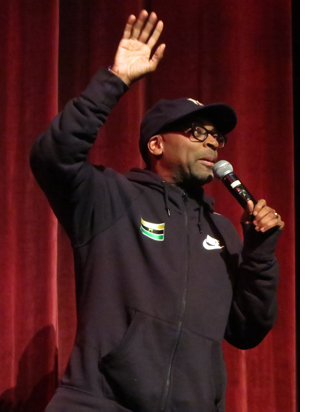 During the Q & A, Spike Lee reminded us that some initial reviews of the film (here shown in a gorgeous 35mm print) had warned that the film could arouse racial tensions. Odie Henderson has charted the alarmist tone of many critiques. Lee insisted, as he has for years, that he was asking questions rather than positing solutions. “We wanted the audience to determine who did the right thing.” He added that the film was, at least, true to the tensions of New York at the time, which were–and still are–unresolved.
During the Q & A, Spike Lee reminded us that some initial reviews of the film (here shown in a gorgeous 35mm print) had warned that the film could arouse racial tensions. Odie Henderson has charted the alarmist tone of many critiques. Lee insisted, as he has for years, that he was asking questions rather than positing solutions. “We wanted the audience to determine who did the right thing.” He added that the film was, at least, true to the tensions of New York at the time, which were–and still are–unresolved.
The ending has become the most controversial part of the film. It’s here that Lee was, I think, especially forceful. The crowd in the street is aghast at the killing of Radio Raheem by a ferocious cop, but what really triggers the riot is Mookie’s act of smashing the pizzeria window. I’ve always taken this as Mookie finally choosing sides. He has sat the fence throughout–befriending one of Sal’s sons and quarreling with the other, supporting Sal in some moments but ragging him in others. Now he focuses the issue: Are property rights (Sal’s sovereignty over his business) more important than human life? Moreover, in a crisis, Mookie must ally himself with the people he lives with, not the Italian-Americans who drive in every day. It’s a courageous scene because it risks making viewers, especially white viewers, turn against that charming character, but I can’t imagine the action concluding any other way. Lee had to move the project to Universal from Paramount, where the suits wanted Mookie and Sal to hug at the end.
Staking so much on social allegory, the film sacrifices characterization. Characters tend to stand for social roles and attitudes rather than stand on their own as individuals. The actors’ performances, especially their line readings, keep the roles fresh, though, and the film still looks magnificent. I was struck this time by the extravagance of its visual style. In almost every scene Lee tweaks things pictorially through angles, color saturation, slow-motion, short and long lenses, and the like–extravagant noodlings that may be the filmic equivalent of street graffiti.
By the end, in order to underscore the confrontation of Radio Raheem and Sal, Lee and DP Ernest Dickerson go all out with clashing, steeply canted wide-angle shots. (We’ve seen a few before, but not so many together and usually not so close.) Having dialed things up pretty far, the movie has to go to 10.
In Born on the Fourth of July, Stone more or less starts at 11 and dials up from there. Beginning with boys playing soldier and shifting to an Independence Day parade that for scale and pomp would do justice to V-J Day, the movie announces itself as larger than life. The storyline is pretty straightforward, much simpler than that of Do The Right Thing. A keen young patriot fired up with JFK’s anti-Communist fervor plunges into the savage inferno of Viet Nam. Coming back haunted and paralyzed, Ron Kovic is still a fervent America-firster until he sees college kids pounded by cops during a demonstration. This sets him thinking, and eventually, after finding no solace in the fleshpots of Mexico, he returns to join the anti-war movement.
Even more than Lee, Stone sacrifices characterization and plot density to a larger message. The Kovic character arc suits Cruise, who built his early career on playing overconfident striplings who get whacked by reality. But again characterization is played down in favor of symbolic typicality. While there’s a suggestion that Ron Kovic joins the Marines partly to prove his manhood after losing a crucial wrestling match, the plot also insists that his hectoring mother and community pressure force him to live up to the model of patriotic young America. He becomes an emblem of every young man who went to prove his loyalty to Mom and apple pie.
Likewise, Ron’s almost-girlfriend in high school becomes a college activist and so their reunion–and her indifference to his concern for her–is subsumed to a larger political point. (The hippies forget the vets.) We learn almost nothing about the friend who also goes into service; when they reunite back home, their exchanges consist mostly of more reflections on the awfulness of the war. Later Cruise is betrayed, almost casually, by an activist who turns out to be a narc. But this man is scarcely identified, let alone given motives: he’s there to remind us that the cops planted moles among the movement.
What fills in for characterization is spectacle. I don’t mean vast action; Stone explained that he had quite a limited budget, and crowds were at a premium. Instead, what’s showcased, as in Do The Right Thing, is a dazzling cinematic technique.
Visiting the UW-Madison campus just before coming to Urbana for Ebertfest, Stone offered some filmmaking advice: “Tell it fast, tell it excitingly.” The excitement here comes from slamming whip pans, thunderous sound, various degrees of slow-motion, silhouettes, jerky cuts, Steadicam trailing, handheld shots, all jammed into the wide, wide frame. Every crack is filled with icons and noises–flags, whirring choppers, kids with toy guns, prancing blondes, commentative music. “Soldier Boy” plays on the supermarket Muzak when Ron is telling Donna about his plans.
By the time Ron visits the family of the comrade he accidentally killed, Stone finds another method of visual italicization: the split-focus diopter that creates slightly surreal depth.
Since so many scenes have consisted of a flurry of intensified techniques, simple over-the-shoulder reverse shots might let the excitement level drop. So a new optical device aims to deliver fresh impact in one of the film’s quietest moments.
Like Lee, Stone took the Virginia Theatre audience behind the scenes. He agreed with William Friedkin, who was originally slated to do the film: “This is as close as you’ll every come to Frank Capra.” Instead of using the shuffled time scheme of Kovic’s autobiography, Friedkin advised that “This is good corn. Write it straight through.” Hence the film breaks into distinct chapters, each about half an hour long and sometimes tagged with dates. They operate as blocks measuring phases of Ron’s conversion. Like many filmmakers of his period, Stone deliberately made each chapter pictorially distinct–the low-contrast Life-magazine colors of the opening parade versus the lava-like orange of the beachfront battle.
Stone pointed out that this film marked the beginning of his career as a figure of public controversy. Like Lee, he was attacked from many sides, and from then on he was a lightning rod. Matt Zoller Seitz (who’s preparing a book on Stone) pointed out that at the period, he was astonishingly prolific. From 1986 (Salvador, Platoon) to 1999 (Any Given Sunday), he directed twelve features, about one a year.
Lee was hyperactive as well over the same years, releasing fourteen films. And neither has stopped. Lee’s new film is the Kickstarter-funded Da Sweet Blood of Jesus, while Stone is touring to support the DVD release of his 2012 documentary series, The Untold History of the United States. Both men like to work, and more important, they’re driven by their ideas as well as their feelings. By seeking new ways to agitate us, they impart an inflammatory energy to everything they try. And in giving them a chance to share their insights and intelligence with audiences outside the Cannes-Berlin-Venice circuit, Ebertfest once again demonstrates its uniqueness. Roger would be proud.
The introductions and Q&A sessions for most of the films, as well as the morning panel discussions, have been posted on Ebertfest’s YouTube page. Program notes for each film are online; see this schedule and click on the title.
For historical background on Barry Allen’s work as an editor of syndicated TV prints, see Eric Hoyt’s new book Hollywood Vault: Film Libraries Before Home Video.
P. S. 1 May 2014: Thanks to Ramin S. Khanjani for pointing out that Ramin Bahrani had worked on other films before Man Push Cart. These included one feature he made in Iran, Biganegan (Strangers, 2000); it got only limited play in festivals and apparently a few theaters. I can’t find information about the others online, and presumably they were shorts and/or did not receive distribution. (K.T.)
Ann Hui, with Kristin, gets into the spirit of Ebertfest. David is represented in absentia by the Dots.












